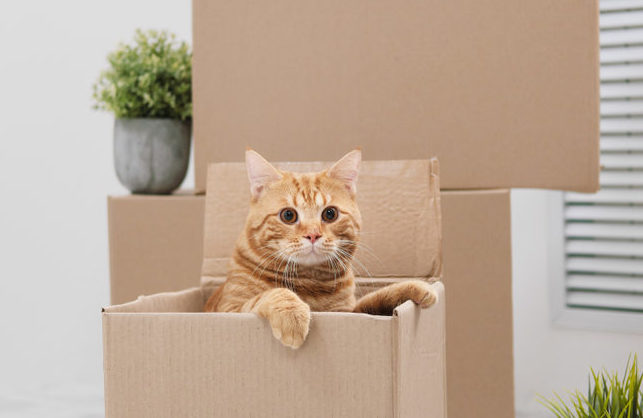Moving with your cat

Cats don’t like change, so it’s not surprising that moving is one of their top stressors. If you’re moving house, take these tips along to help ensure your kitty withstands the transition as smoothly as possible.
Moving house is a stressful life event — or at the very least, a major hassle, even if you look forward to the change. Cats, however, don’t like change. They form strong attachments to their surroundings and, as masters of routine, find moving highly stressful. Considerate planning ahead of time makes the transition less stressful for your cat, thereby reducing the risk of fear- or anxiety-based behaviors such as litter box mishaps, hiding, excessive vocalization, escape attempts and aggression. Whether you’re moving to another state, across town, or downstairs in the same building, here are some tips to make the change less stressful for your cat.
 Preparing your cat
Preparing your cat
“The secret to moving with cats is planning ahead,” says certified feline behavior and training consultant, Dr. Marci Koski. “This means gradually preparing your cat for the upcoming move, and starting as far ahead of time as possible.”
- Teach your cat to feel comfortable inside her carrier. If she’s super aversive to it, perhaps because she associates it with vet visits, this step should be taken very early on. Incorporate the carrier into your cat’s environment by leaving it out, with the door open, in a room your cat is familiar with. Encourage her to casually explore it by using positive reinforcement. Toss in a few favorite toys or treats, or feed her near or in the carrier. A bed or blanket that retains a familiar scent can also be placed inside to provide a sense of security, and/or cover the carrier with a towel or blanket to create a safe hideaway.
- Cats like boxes — but a sudden influx of moving boxes and a flurry of packing activity incites stress and anxiety. Bring in the boxes a couple of weeks before you start packing so your cat has time to acclimatize to their presence and smell. Pack gradually, so your cat can adjust to the changes. If she’s nervous, or likes to hide in or explore the boxes while you’re packing, it’s a good idea to confine her to a quiet room.
- Follow your cat’s normal routine for feeding, playtime and attention. You can’t do much about the changes to your cat’s environment, but you can stick to her routine as closely as possible, including on moving day. “The stability of routine is comforting to cats, so try to hang on to the routine as long as you can,” Dr. Koski advises.
- Some cats are naturally more anxious than others. If yours is one of them, talk to your vet. “Consider calming supplements or even medication from your vet to keep your cat from getting overly stressed,” says Dr. Koski. Bach Rescue Remedy is another effective way to reduce stress. Just gently rub a bit on her ears, or add a few drops to her drinking water.
- Make sure your cat is microchipped and/or wears a a collar with an ID tag. Double check that the chip is registered, and update your contact information. “Do not go anywhere without having your cat’s identification present and updated!” cautions Dr. Koski. “There are so many opportunities for cats to disappear during a move – when the moving truck is being loaded or unloaded, when a door is opened, etc.”
Moving day
Keeping your cat safe and secure on moving day is your number one priority. Anxiety will likely be high for everyone, but a bit of forethought can make it easier for your cat.
- On the day of your move, set up a safe room for your cat in the old house. It can be a bathroom or emptied bedroom. Put your cat’s food, water, litter box, carrier, toys and bed in the room. Attach a sign to the door noting that your cat is in there and the door must remain closed. Your cat may not be happy being locked away, but you’ll feel better knowing she’s safe.
- Feed your cat a smaller meal on moving day to help prevent tummy upset.
- Put your cat in the carrier just before you’re ready to leave. Only open the carrier door when the cat is in a secure, enclosed area. “Keep your cat in the carrier at all times when she’s in a vehicle,” adds Dr. Koski. “It’s so easy for a cat to get stuck somewhere in a packed car, and then accidentally escape. If she panics, she can also get somewhere in the vehicle that isn’t safe for the driver. Always keep your cat’s safety in the forefront when traveling.”
“You are the most familiar thing your cat has during a move,” says Dr. Koski. “You are also the one who is best able to determine what she needs. As her guardian, her well-being is your responsibility during this stressful time of change.”




